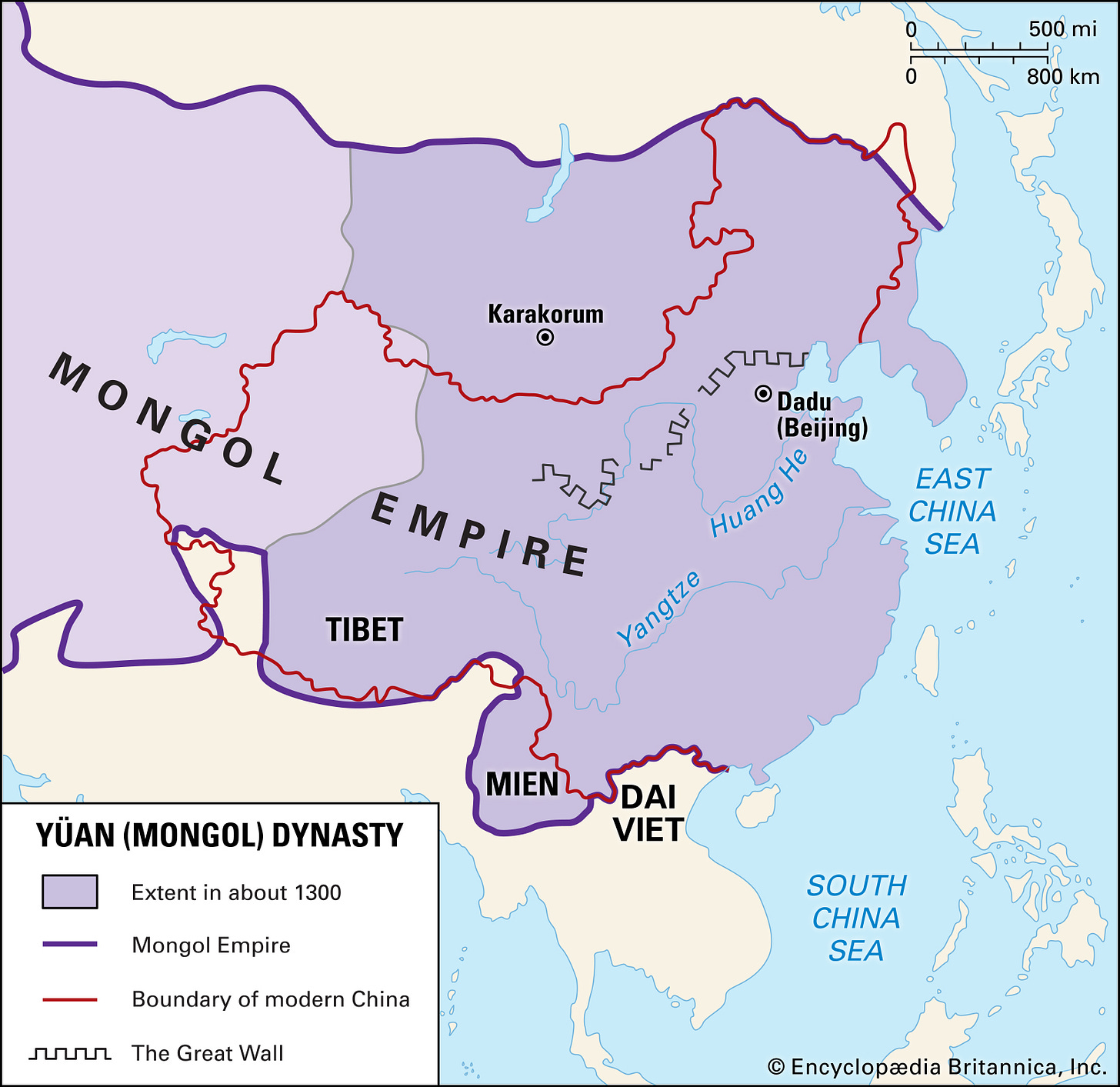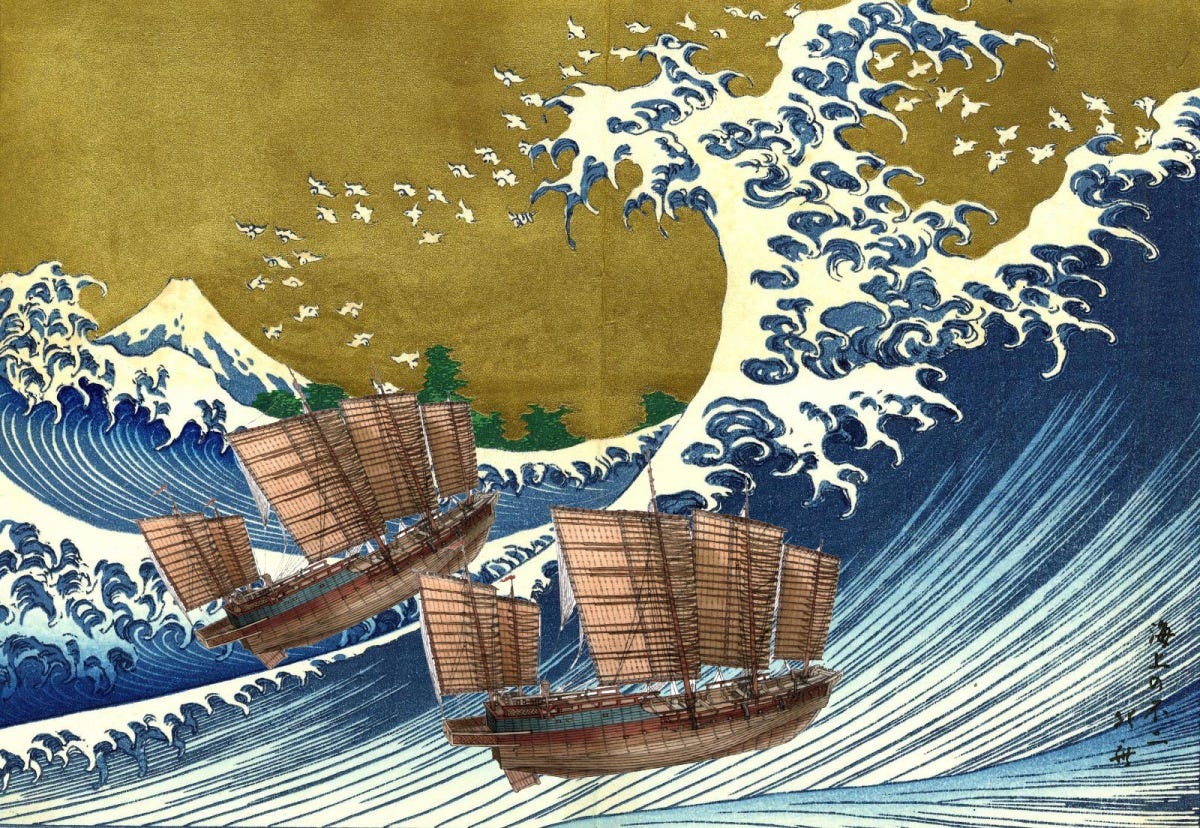Dear fellow China watchers,
Today I’m returning to my History of China series. As I’ve said many times before, it is impossible to understand either the nature of modern China, or the actions of its leaders, without a knowledge of the country’s past. One of the reasons that foreign dominance is so despised, for example, is the lingering ancestral memory of the cruelty meted out by one of the non-Chinese dynasties to rule the empire - although, to be fair, not many peoples enjoyed being conquered by the Mongols.
In case you want to read more about China’s history, here are the links to where we’ve got to so far:
Introduction to 5,000 years of Chinese history
The first Dynasty, the Xia (2070 BC – 1600 BC) – they who tamed the rivers.
The second Dynasty, the Shang (1600 BC – 1046 BC) – they who developed writing.
The third Dynasty, the Zhou (1046 BC – 221 BC) – they who started the Mandate of Heaven.
The Warring States Period (475 BC – 221 BC) – seven states and the bloody struggle for hegemony.
The First Emperor and the Qin Dynasty (221 BC to 207 BC) – he who unified China for the first time.
The Han Dynasty, Rome's Equals in the East (202 BC - AD 220) – they who established China as an international power.
The Fall of the Han - the end of the first long-lasting Dynasty.
The Tang Dynasty (618-907) - they who are still revered as the apogee of Chinese civilisation.
The Song Dynasty (960-1279) - they who nearly managed the world’s first industrial revolution, but settled for bank notes and foot binding instead.
As part of the historical series I’ve also done a beginner’s primer on Confucianism, which covers a bit of Legalism too.
Whilst we are on the subject of history and culture, I want to give a heads-up about another Substack newsletter that I find really interesting, and which you may well to.
Slow Chinese 每周漫闻 by the insightful Andrew Methven is a weekly newsletter aimed at anyone who wants to improve their native Chinese language skills, and at the same time understand the latest language trends in China. We’re talking slang/internet words/idioms/colloquialisms, all the stuff you won’t be taught by state-sponsored tutors.
In the latest newsletter, he teaches you the words you need to deal with a rude tourist, but also some insights into the glorious new fad in China of “script killing”. (I’m going to write a post about this separately.) If you have any interest in the Chinese language then this newsletter is for you.
I hope you enjoy my Mongolian post below, and please remember to consider commenting, liking, sharing, and subscribing.
Many thanks for reading - and remember to check out Slow Chinese!
***
“In Xanadu did Kubla Khan
A stately pleasure-dome decree”
So reads the opening lines of one of the most famous of Western romantic poems, “Kubla Khan”, by Samuel Taylor Coleridge. He was writing about Xanadu, a fabled land of luxury that had become famed throughout the world for its “gardens bright with sinuous rills” and “incense-bearing trees”. Flowery though some of the language is, the place in question was based on a real city, Shangdu, which was one of the capitals of the short-lived Mongol reign of China.
The Yuan Dynasty was founded by Kublai Khan, and although it only lasted for ninety-seven years, had a profound effect in the mindset of China, thanks to the embarrassment and indignation of foreign rule. In the history of great powers, it’s often an uncomfortable truth that they have at some point been ruled by outsiders. England is an obvious example – not only by the Normans, but by the Dutch too – and America of course started life as a British colony. China is no exception.
Genghis Khan (c.1158-1227) had brought the various Mongol tribes into confederation, and after conquering some western neighbours, turned his attention to the Jin. If you recall from last time, the Jin – who were also nomadic cavalrymen – had conquered northern China from 1125, living in a difficult peace with the rump of the Song Dynasty, who still controlled the south from their capital Nanjing.
The Jin were destroyed by the Mongols, and their Chinese lands absorbed into the burgeoning Mongol empire. Genghis and his successor then turned their attention once more West, and conquered thousands of miles of Eurasian land, right up to the borders of Hungary.

In 1279, the grandson of Genghis, Kublai Khan, decided to go after the Southern Song after a foolhardy series of raids by the Chinese. The Song, still militarily fragile, didn’t stand a chance. The last emperor, a boy of seven called Bing, was killed alongside a hundred thousand soldiers and court officials in a final battle just along the coast from Hong Kong.
The new dynasty, named the Yuan, was not an outstanding success, and lasted less than a century. In many ways it marked a regression from the Song, which had developed into a proto-market economy with extensive cultural achievements, as well as a long list of incubated new technologies, from gunpowder to the marine compass.
The Mongols, by contrast, introduced a feudal hierarchy, a brutal reversion not only for the economy and technology, but in day to day life too. The first forays into China by the Mongols had seen the horsemen adopt the standard rape-and-burn approach (it’s not a coincidence that one in 200 men alive today are thought to descend from Genghis), but soon they realised that it would be more profitable to allow the Chinese to stay alive and pay taxes. The people kept their heads, but were forced to endure the most pernicious form of colonial oppression. This social and economic hardship, together with plague and famine that swept throughout the land, saw the empire’s population decline throughout Mongol era.
Nonetheless, with Mongol rule by then stretching across Eurasia, trade was able to flourish, and new types of food like the carrot headed east. Foreign religions spread too. Islam increased in popularity, and it was under the Mongols that Christianity in China reached its zenith. Most were Nestorian Christians (who were broadly a branch of Eastern Christianity), although there were some Roman Catholics too. Buddhism was encouraged, but Taoism, being an innate national symbol of China, was suppressed.
Pax Mongolia also provided a way for Europeans to travel to China for the first time en masse, which they did, with many thousands making the arduous trip. This included the most famous of all the Yuan’s observers, Marco Polo. Arriving in China in 1275, four years before the fall of the Song, his book of travels light up our understanding of life in thirteenth century China.
Although some claim that Polo never actually reached China, this is somewhat beside the point when it comes to his writing’s most important consequence: his portrayals of China’s riches are thought by many to have been the spark that lit the European Age of Exploration. Christopher Columbus himself was inspired to sail out to the horizon by dreams of trade with the Emperor, and he took with him on his first voyage to the New World a heavily annotated copy of The Travels of Marco Polo.
In Asia, the Yuan’s foreign relations are remembered with far less fondness.
Mongol success on the battlefield encouraged further ideas of expansion, and they created a methodology to do so. First, the Mongols would dispatch envoys to the targeted state demanding their submission, in the form of tribute. The king of the selected state would also be ordered to appear at the court of the Yuan Emperor to pay his respects.
If, however, a positive answer was not immediately forthcoming, then a second embassy would be sent. The Mongol envoys would turn the heat up with numerous threats and insults, something that often led to a strong pushback from the hosts. The Burmese, for example, beheaded a Mongolian mission, and the Javanese “defaced” the embassy’s leader. The Mongols in turn would use these slights to launch an invasion – following on from the Javanese incident, the Yuan emperor dispatched a thousand ships and twenty thousand men on a punitive raid.

The same pattern of aggressive outreach was used against Japan. The Mongols were especially rude to the Japanese emperor, for reasons known only to them, with Kublai Khan insisting on calling the Japanese emperor “the king of a little country”.
The back and forth of insults and retaliation led to two different invasions. The first one was in 1274, when the emperor ordered an invasion that cost the lives of thirteen thousand soldiers when the fleet was sunk by a typhoon. Then, in 1281, a second, even grander invasion was launched. The two fleets that were sent that numbered up to 140,000 men, the biggest maritime invasion in history until D-Day in 1944. Thankfully for the Japanese, the Kamikaze, or “Divine Winds”, appeared again, and half the men drowned.
The failed invasions of Japan were the costliest defeats the Mongols encountered, and came at a bad time for China’s new rulers. Plague and famine were still stalking the country, and their rout on the sea set the public tongue wagging that their Mandate from Heaven was starting to slip.
In 1351 Song loyalists launched the Red Turban rebellions. The Mongol court was riven by infighting and was unable to mount a serious challenge to the rebels, whose ranks were swelled by Han tired of both foreign rule and the natural disasters coming thick and fast.
The war that followed was vicious, and there were particularly gruesome punishments meted out to captured Yuan officers: one was reported to have been flayed alive and his stomach cut out. A century of festering rage against foreign occupation was being released.
One of the Red Turban leaders is one of the more interesting of characters from Chinese history. Zhu Yuanzhang was born in eastern China to a family of impoverished farmers. His early years were partly spend wandering as a beggar, then a Buddhist monk until the monastery he was living in was destroyed by an army suppressing a local rebellion. Zhu drifted into the Red Turbans where he quickly rose up the ranks to become one of its dominant commanders.
After victory against one of his rivals at the 1363 Battle of Poyang Lake, one of the largest naval battles in history where roughly half a million men drowned or burnt to death, the way was clear for Zhu to finally expel the Mongols. In 1368 the Yuan abandoned their capital at Beijing and fled back to Mongolia, allowing Zhu to declare himself the Hongwu Emperor. It was the start of one of the so-called “good” dynasties of China, the Ming – who we will look at next time.



